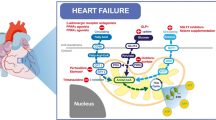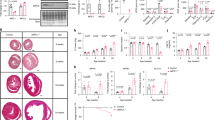Abstract
Oxidative metabolism of blood-borne fuels provides myocardium the energy required to sustain its contractile performance. Recent research has revealed that, in addition to supplying energy, certain fuels are able to detoxify harmful oxidants and bolster the myocardium's endogenous antioxidant defenses. These antioxidant capabilities could potentially protect the myocardium from the ravages of reactive oxygen and nitrogen intermediates generated upon reperfusion of ischemic myocardium. This article reviews experimental evidence that two fuels, pyruvate and acetoacetate, provide such antioxidant protection. Pyruvate's antioxidant properties stem in part from its α-keto carboxylate structure, which enables it to directly, non-enzymatically neutralize peroxides and peroxynitrite. Also, citrate, which accumulates in pyruvate-perfused myocardium following anaplerotic pyruvate carboxylation, supports NADPH production to maintain glutathione:glutathione disulfide (GSH/GSSG) redox potential, the central component of the myocardial antioxidant system. Like pyruvate, acetoacetate restores GSH/GSSG and increases contractile function of post-ischemic stunned myocardium, although some of its antioxidant mechanisms may differ from pyruvate's. Both compounds restore β-adrenergic signaling and inotropism, which are compromised in stunned myocardium. N-acetylcysteine, a pharmacological antioxidant that does not provide energy, duplicated the salutary effects of pyruvate and acetoacetate on post-ischemic β-adrenergic signaling and GSH/GSSG. These findings reveal novel, energy-independent mechanisms for enhancement of post-ischemic cardiac performance by metabolic fuels.
Similar content being viewed by others
References
Alberola A, Such L, Gil F, Zaragoza EJ, Morcillo EJ: Protective effect of N-acetylcysteine on ischaemia-induced myocardial damage in canine heart. Naunyn-Schmiedeberg's Arch Pharmacol 343: 505-510, 1991
Tang L-D, Sun J-Z, Wu K, Sun C-P, Tang Z-M: Beneficial effects of N-acetyleysteine and cysteine in stunned myocardium in perfused rat heart. Br J Pharmacol 102: 601-606, 1991
Bolli R, Marbán E: Molecular and cellular mechanisms of myocardial stunning. Physiol Rev 79: 609-634, 1999
Kuo W-N, Kreahling JM, Shanbhag VP, Shanbhag PP, Mewar M: Protein nitration. Mol Cell Biochem 214: 121-129, 2000
Dhalla NS, Elmoselhi AB, Hata T, Makino N: Status of myocardial antioxidants in ischemia-reperfusion injury. Cardiovasc Res 47: 446-456, 2000
Schafer FQ, Buettner GR: Redox environment of the cell as viewed through the redox state of the glutathione disulfide/glutathione couple. Free Radic Biol Med 30: 1191-1212, 2001
Kukreja RC, Hess ML: The oxygen free radical system: From equations through membrane-protein interactions to cardiovascular injury and protection. Cardiovasc Res 26: 641-655, 1992
Charlat ML, O'Neill PG, Egan JM, Abernethy DR, Michael LH, Myers ML, Roberts R, Bolli R: Evidence for a pathogenetic role of xanthine oxidase in the 'stunned' myocardium. Am J Physiol Heart Circ Physiol 252: H566-H577, 1987
Yu BP: Cellular defenses against damage from reactive oxygen species. Physiol Rev 74: 139-162, 1994
Beckman JS, Koppenol WH: Nitric oxide, superoxide, and peroxynitrite: The good, the bad, and the ugly. Am J Physiol Cell Physiol 271: C1424-C1437, 1996
Savvides SN, Scheiwein M, Böhme CC, Arteel GE, Karplus PA, Becker K, Schirmer RH: Crystal structure of the antioxidant enzyme glutathione reductase inactivated by peroxynitrite. J Biol Chem 277: 2779-2784, 2002
Radi R, Beckman JS, Bush KM, Freeman BA: Peroxynitrite-induced membrane lipid peroxidation: The cytotoxic potential of superoxide and nitric oxide. Arch Biochem Biophys 288: 481-487, 1991
Cheung P-Y, Wang W, Schulz R: Glutathione protects against myocardial ischemia-reperfusion injury by detoxifying peroxynitrite. J Mol Cell Cardiol 32: 1669-1678, 2000
Heales SJR, Bolaños JP: Impairment of brain mitochondrial function by reactive nitrogen species: The role of glutathione in dictating susceptibility. Neurochem Int 40: 469-474, 2002
Yasmin W, Strynadka KD, Schulz R: Generation of peroxynitrite contributes to ischemia-reperfusion injury in isolated rat hearts. Cardiovasc Res 33: 422-432, 1997
Bolli R: Postischemic myocardial 'stunning': Pathogenesis, pathophysiology, and clinical relevance. In: D.M. Yellon, R.B. Jennings (eds). Myocardial Protection: The Pathophysiology of Reperfusion and Reperfusion Injury. Raven Press, New York, 1992, pp 105-149
Bolli R, Jeroudi MO, Patel BS, Aruoma OI, Halliwell B, Lai EK, McCay PB: Marked reduction of free radical generation and contractile dysfunction by antioxidant therapy begun at the time of reperfusion. Circ Res 65: 607-622, 1989
Weisel RD, Mickle DAG, Finkle CD, Tumiati LC, Madonik MM, Ivanov J, Burton GW, Ingold KU: Myocardial free-radical injury after cardioplegia. Circulation 80(suppl III): III14-III18, 1989
Janero DR, Hreniuk D, Sharif HM: Hydrogen peroxide-induced oxidative stress to the mammalian heart-muscle cell (cardiomyocyte): Lethal peroxidative membrane injury. J Cell Physiol 149: 347-364, 1991
Bagchi M, Prasad MR, Engleman RM, Das DK: Effects of free radicals on the fluidity of myocardial membranes. Free Radic Res Commun 7: 375-380, 1989
Lebedev AV, Levitsky DO, Loginov VA, Smirnov VN: The effect of primary products of lipid peroxidation on the transmembrane transport of calcium ions. J Mol Cell Cardiol 14(suppl 3): 99-103, 1982
Eaton P, Hearse DJ, Shattock MJ: Lipid hydroperoxide modification of proteins during myocardial ischemia. Cardiovasc Res 51: 294-303, 2001
Chatham JC, Gilbert HF, Radda GK: The metabolic consequences of hydroperoxide perfusion on the isolated rat heart. Eur J Biochem 184: 657-662, 1989
Janero DR, Hreniuk D, Sharif HM: Hydroperoxide-induced oxidative stress impairs heart muscle cell carbohydrate metabolism. Am J Physiol Cell Physiol 266: C179-C188, 1994
Vlessis AA, Muller P, Bartos D, Trunkey D: Mechanism of peroxide-induced cellular injury in cultured adult cardiac myocytes. FASEB J 5: 2600-2605, 1991
Radi R, Rodriguez M, Castro L, Telleri R: Inhibition of mitochondrial electron transport by peroxynitrite. Arch Biochem Biophys 308: 89-95, 1994
Tretter L, Adam-Vizi V: Inhibition of Krebs cycle enzymes by hydrogen peroxide: A key role of α-ketoglutarate dehydrogenase in limiting NADH production under oxidative stress. J Neurosci 20: 8972-8979, 2000
Tatsumi T, Kako KJ: Effects of hydrogen peroxide on mitochondrial enzyme function studied in situ in rat heart myocytes. Basic Res Cardiol 88: 199-211, 1993
Goldhaber JI, Qayyum MS: Oxygen free radicals and excitation-contraction coupling. Antioxid Redox Signal 2: 55-64, 2000
Kukreja RC, Weaver AB, Hess ML: Sarcolemmal Na+,K+-ATPase: Inactivation by neutrophil-derived free radicals and oxidants. Am J Physiol Heart Circ Physiol 259: H1330-H1336, 1990
Shao Q, Matsubara T, Bhatt SK, Dhalla NS: Inhibition of cardiac sarcolemma Na+-K+ ATPase by oxyradical generating systems. Mol Cell Biochem 147: 139-144, 1995
Josephson RA, Silverman HS, Lakatta EG, Stern MD, Zweier JL: Study of the mechanisms of hydrogen peroxide and hydroxyl free radical-induced cellular injury and calcium overload in cardiac myocytes. J Biol Chem 266: 2354-2361, 1991
Molina H, Garcia M: Enzymatic defenses of the rat heart against lipid peroxidation. Mech Ageing Dev 97: 1-7, 1997
Jung CH, Thomas JA: S-glutathiolated hepatocyte proteins and insulin disulfides as substrates for reduction by glutaredoxin, thioredoxin, protein disulfide isomerase, and glutathione. Arch Biochem Biophys 335: 61-72, 1996
Freislaben H-J, Packer L: Free-radical scavenging activities, interactions and recycling of antioxidants. Biochem Soc Trans 21: 325-330, 1993
Kehrer JP, Lund LG: Cellular reducing equivalents and oxidative stress. Free Radic Biol Med 17: 65-75, 1994
Mallet RT: Pyruvate: Metabolic protector of cardiac performance. Proc Soc Exp Biol Med 223: 136-148, 2000
Mallet RT, Bünger R: Energetic modulation of cardiac inotropism and sarcoplasmic reticular Ca2+ uptake. Biochim Biophys Acta 1224: 22-32, 1994
Mallet RT, Sun J: Mitochondrial metabolism of pyruvate is required for its enhancement of cardiac function and energetics. Cardiovasc Res 42: 149-161, 1999
Martin BJ, Valdivia HH, Bünger R, Lasley RD, Mentzer RM Jr: Pyruvate augments calcium transients in rat ventricular myocytes. Am J Physiol Heart Circ Physiol 274: H8-H17, 1998
Chen W, London R, Murphy E, Steenbergen C: Regulation of the Ca2+ gradient across the sarcoplasmic reticulum in perfused rat heart: A 19F nuclear magnetic resonance study. Circ Res 83: 898-907, 1998
Zhou Z, Lasley RD, Hegge JO, Bünger R, Mentzer RM Jr: Myocardial stunning: A therapeutic conundrum. J Thorac Cardiovasc Surg 110: 1391-1401, 1995
Zhang J, Toher C, Erhard M, Zhang Y, Ugurbil K, Bache RJ, Lange T, Homans DC: Relationships between myocardial bioenergetic and left ventricular function in hearts with volume-overload hypertrophy. Circulation 96: 334-343, 1997
Tejero-Taldo MI, Sun J, Caffrey JL, Mallet RT: Pyruvate potentiates β-adrenergic inotropism of stunned guinea-pig myocardium. J Mol Cell Cardiol 30: 2327-2339, 1998
Kiuchi K, Shen YT, Vatner SF, Vatner DE: Mechanisms mediating responsiveness to beta-adrenergic stimulation after coronary reperfusion in conscious dogs. Am J Physiol Heart Circ Physiol 267: H1578-H1588, 1994
Persad S, Takeda S, Panagia V, Dhalla NS: β-adrenoceptor-linked signal transduction in ischemic-reperfused heart and scavenging of oxyradicals. J Mol Cell Cardiol 29: 545-558, 1997
Persad S, Rupp H, Jindal R, Arneja J, Dhalla NS: Modification of cardiac β-adrenoceptor mechanisms by H2O2. Am J Physiol Heart Circ Physiol 274: H416-H423, 1998
Tejero-Taldo MI, Caffrey JL, Sun J, Mallet RT: Antioxidant properties of pyruvate mediate its potentiation of β-adrenergic inotropism in stunned myocardium. J Mol Cell Cardiol 31: 1863-1872, 1999
Constantopoulos G, Barranger JA: Nonenzymatic decarboxylation of pyruvate. Anal Biochem 139: 353-358, 1984
Vásquez-Vivar J, Denicola A, Radi R, Augusto O: Peroxynitrite-mediated decarboxylation of pyruvate to both carbon dioxide and carbon dioxide radical anion. Chem Res Toxicol 10: 786-794, 1997
Comte B, Vincent G, Bouchard B, Jetté M, Cordeau S, Des Rosiers C: A 13C mass isotopomer study of anaplerotic pyruvate carboxylation in perfused rat hearts. J Biol Chem 272: 26125-26131, 1997
Peuhkurinen KJ, Hassinen IE: Pyruvate carboxylation as an anaplerotic mechanism in the isolated perfused rat heart. Biochem J 202: 67-76, 1982
Russell RR III, Taegtmeyer H: Pyruvate carboxylation prevents the decline in contractile function of rat hearts oxidizing acetoacetate. Am J Physiol Heart Circ Physiol 261: H1756-H1762, 1991
Garland PB, Randle PJ, Newsholme EA: Citrate as an intermediary in the inhibition of phosphofructokinase in rat heart muscle by fatty acids, ketone bodies, pyruvate, diabetes and starvation. Nature 200: 169-170, 1963
Hermann HP, Zeitz O, Keweloh B, Hasenfuss G, Janssen PM: Pyruvate potentiates inotropic effects of isoproterenol and Ca2+ in rabbit cardiac muscle preparations. Am J Physiol Heart Circ Physiol 279: H702-H708, 2000
Hermann HP, Zeitz O, Lehnart SE, Keweloh B, Datz N, Hasenfuss G, Janssen PM: Potentiation of beta-adrenergic inotropic response by pyruvate in failing human myocardium. Cardiovasc Res 53: 116-123, 2002
Sun J, Squires J, Mallet RT: Acetoacetate restores contractile performance and antioxidant potential of H2O2-injured myocardium. J Mol Cell Cardiol 33: A115, 2001
Squires JE, Sun J, Caffrey JL, Yoshishige D, Mallet RT: Acetoacetate augments β-adrenergic inotropism of stunned myocardium by an antioxidant mechanism. Am J Physiol Heart Circ Physiol 284: H1340-H1347, 2003
Goodwin GW, Ahmad F, Doenst T, Taegtmeyer H: Energy provision from glycogen, glucose, and fatty acids on adrenergic stimulation of isolated working rat hearts. Am J Physiol Heart Circ Physiol 274: H1239-H1247, 1998
Uppu RM, Pryor WA: Carbon dioxide catalysis of the reaction of peroxynitrite with ethyl acetoacetate: An example of aliphatic nitration with peroxynitrite. Biochem Biophys Res Commun 229: 764-769, 1996
Menahan LA, Hron WT: Regulation of acetoacetyl-CoA in isolated perfused rat hearts. Eur J Biochem 119: 295-299, 1981
Hashimoto F, Hayashi H: Significance of catalase in peroxisomal fatty acyl-CoA β-oxidation: NADH oxidation by acetoacetyl-CoA and H2O2. J Biochem 108: 426-431, 1990
Mallet RT, Hartman DA, Bünger R: Glucose requirement for post-ischemic recovery of perfused working heart. Eur J Biochem 188: 481-493, 1990
Taegtmeyer H: On the inability of ketone bodies to serve as the only energy providing substrate for rat heart at physiological work load. Basic Res Cardiol 78: 435-450, 1983
Humphries KM, Juliano C, Taylor SS: Regulation of cAMP-dependent protein kinase activity by glutathionylation. J Biol Chem 277: 43505-43511, 2002
Hermann H-P, Pieske B, Schwarzmüller E, Keul J, Just H, Hasenfuss G: Haemodynamic effects of intracoronary pyruvate in patients with congestive heart failure: An open study. Lancet 353: 1321-1323, 1999
Olivencia-Yurvati AH, Blair JL, Baig M, Mallet RT: Pyruvate-enhanced cardioprotection during cardiopulmonary bypass surgery. J Cardiothorac Vasc Anesth (in press)
Author information
Authors and Affiliations
Rights and permissions
About this article
Cite this article
Mallet, R.T., Sun, J. Antioxidant properties of myocardial fuels. Mol Cell Biochem 253, 103–111 (2003). https://doi.org/10.1023/A:1026009519783
Issue Date:
DOI: https://doi.org/10.1023/A:1026009519783




